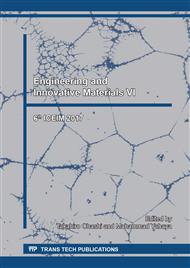p.280
p.286
p.292
p.297
p.302
p.307
p.312
p.318
p.325
Development of Natural Fiber as a Filter Media in Removing Organic Pollutants from Greywater
Abstract:
Greywater is a wastewater originating from shower, bathtub, bathroom sink, kitchen sink and laundry. Despite the fact of wastewater in Malaysia may also include a complex mixture of organic matter, suspended solids, bacteria and common household chemicals, when used wisely and in a manner that is protective to public health and the environment, it can helps preserve limited water supply. This study aims the efficiency of adsorption of organic pollutants in greywater by using natural fibers such as Kenaf dust and Chitosan powder to treat the colour of water and the cause of odours from the greywater. The objective of this research is to identify the characteristics of greywater according to standard effluent discharge, as well as to characterize the physical properties of Kenaf (Hibiscus Cannabinus L.) and to determine the percent removal parameters of greywater by using Kenaf dust and Chitosan powder as organic removal. Raw greywater samples were taken at main drain Kompleks Parit Raja. The results for raw greywater samples obtained such as COD (253 mg/l), TSS (1800 mg/l), pH (5.89) and turbidity (47.5 NTU) were compared to Effluent Standard Discharge (EQA 1974). The COD removal efficiencies by using kenaf dust and chitosan powder amounted to 51% and 50 %, also TSS removal 89% and 100%. The pH and turbidity amounted to 6.76 and 7.04, 46 NTU and 4.46 NTU respectively. The overall removal of organic pollutants increased with different mass of adsorbents, then the optimum adsorbents were selected 30%, 40% and 50% to form as beads.
Info:
Periodical:
Pages:
302-306
Citation:
Online since:
January 2018
Keywords:
Price:
Сopyright:
© 2018 Trans Tech Publications Ltd. All Rights Reserved
Share:
Citation:


